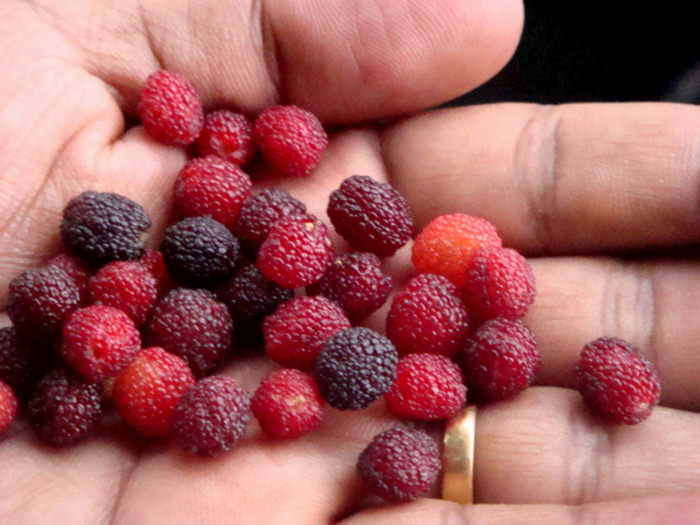If we talk about our numerous planned and unplanned trips to our village, we cannot forget the flavour of the juicy kafals that have stayed on our lips for years. For those who haven’t tasted this fruit should try it once at least. Kafal whose biological name is Myrica Esculenta is a deep red coloured berry, having a sweet and tangy flavour. It grows at an altitude of 1,000-2,000 metres above sea level and tastes delicious when dressed with salt, rock salt, and chilli powder. This citrus fruit not only tastes good but is also famous for its antioxidant properties which help in slowing down the aging process.

Src: blogspot.in
We can go on and on about praising this but do you know there is a heart-touching local lore related to kafal? If no, then stay tuned. Once upon a time in a remote village of Uttarakhand lived a poor lady along with her small daughter. They had nobody to call their own and somehow survived by farming on their small share of land. Since they had no other source of livelihood, they used to wait for the summers to arrive as the kafals or bayberries would be laden on the forest trees and it was a golden opportunity to make some money. On one such summery day, the poor lady went to the forest for plucking bucketful of ripe kafals to sell in the evening market. On returning home, she told her little daughter to look after them as she had to collect fodder for the animals. She also promised to give her plenty of them on returning home.

The little girl listened to her mother’s advice and looked after them. The sight of the ripe fruits tempted her jaded palates to taste some, but she somehow managed to calm down her spirits. When a few hours later her mother arrived, she became pot boiled to see that two-third of the kafals have vanished, while her daughter was sleeping next to it. On arranging the events, she came to the conclusion that her daughter had eaten all the fruits while she was collecting fodder for the animals. In a flinch of sight, she threw the bundle of grass on the floor and in the anguish of having her instructions disobeyed, she gave a powerful punch on her daughter’s back. After few minutes when the poor lady didn’t notice any movement in her daughter’s body, she realized that her ferocious punch had made her go from sleeping to the state of coma.

Src: ghumakkar.com
She tried everything to bring her daughter back to consciousness, but it all went in vain as the little girl had already died. On realizing that she has lost her only daughter, the tears roll down her face like the broken pieces of a chandelier and she grieved until evening. When the sun came down and the room became a bit gloomy, the poor lady was shocked to see that the half emptied bucket was now full of ripe bayberries. When she had a closer look at it, she figured out that the fresh breeze of the evening had made the berries to gain their original shape which had earlier shrunken due to overheating. The poor lady then felt an enormous amount of guilt for what she had done to her little daughter and soon passed away with immense sorrow and guilt in her heart.

Src: uttarakhand.org.in
This soul-wrenching tale not only touches our heart but also emphasize the importance of kafal in Uttarakhand. Even today, during summer season many Pahari families pluck this fruit from the jungle to sell it for earning a living. It is believed that during Chait, the first month according to the traditional Hindu calendar, a bird hymns “Kafal Pako Min Ni Chakho” that means, ‘the Kafals have ripened but I haven’t tasted them’ to which the other bird respond “Purray Putti Purray Pur” meaning ‘they are complete daughter, they are complete’. In one of the famous folk song of Kumaon, kafal has been described as the fruit of gods and it expresses its grief by singing “Khanaa Layak Indra Ka, Humchhiyan Bhoolok Aain Padan” meaning ‘we are meant to be eaten by Lord Indra in heaven but have been moved to earth’.
Wow. Lovely write up. Keep writing about kumaon and keep the culture alive. Keep it up.
At my hometown their is a 110 years old Kafal tree and it’s giving us Kafal still now .
Really such a stunning pics of Kafal clicked by photographer.
Thanks :)
Nice and touching.. Keep it up.
Thanks for your comment and this lovely video but the image used in the article is just for representation.
Hi,
The image of the bird shown in your article is of an’ Oriental white eye’. However, the bird in the this story, I believe is ‘Indian Cockoo’.
https://www.youtube.com/watch?v=mWO8rcRjumE